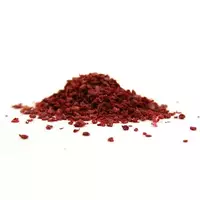Seasoning sumac

Sumac seasoning is popular in Jewish and Muslim cuisines, where this ruby spice, which perfectly replaces lemon, is used in everyday cooking. In fact, sumac or sumac is the berries of a small shrub, which belongs to the Pistachio family (Anacardiaceae) and is native to Central and Central Asia, the countries of the Middle East, the Mediterranean and the Caucasus.
In total, there are up to two hundred and fifty species of sumac in the world today. Interestingly, in Aramaic, Sumaqa means red, while the Latin name for the species Coriarius is leather. The plant bears fruit quite abundantly - sometimes up to five hundred fruits are collected from one shrub, which are pubescent ruby berries up to eight millimeters in diameter.
Sumac seasoning is used as a spice, which gives the dishes a characteristic sourness to help keep food suitable in countries with hot climates. It is recommended to store this spice in sealed packaging (best made of ceramic) in a dark place. By the way, the loss of ruby in the seasoning of sumac suggests that the shelf life of the additive has expired.
The seasoning of sumac contains many useful substances, including tannins, apple, wine, lemon, amber, fumaric, maleic and ascorbic acids. These natural compounds determine not only the taste, but the useful properties of sumac. In addition, volatile oils consisting of aldehydes and terpenoids as well as fatty oils are present in the product. Due to the presence of anthocyanin pigments, the spice has a ruby color.
To taste, the seasoning of sumac is very acidic, so it is used in minimal quantities. Most often it is added to salads, meat and fish dishes. Sumac is perfectly combined with poultry, legumes, cereals and vegetables. In addition, sumac seasoning is excellent when creating sauces, pickling, braising, preparing dressings, as well as when canning.
Often this seasoning is added to kebabs, kebabs, barbecues, for which the meat is preliminarily sprinkled with spice or soaked in a marinade with ruby spice. Grilled meals are simply perfectly suited to natural yogurt sauce and sumac seasoning. You can add it to the composition of cheeses, sausages, minced meat and fillings, as well as pilaf. In addition, this sour spice shades the taste of desserts and drinks quite well.
Another area of use of the multifaceted properties of sumac is primarily medicine, but this spice is often used as a dye, tannin and additive in tobacco mixtures. For medical purposes, sumac plays the role of an antioxidant, helping to rid the body of slags and other harmful substances. In addition, this seasoning contributes to the normalization of digestive processes and has a beneficial effect on the human condition in diabetes mellitus.
seasoning of soums 0 kCal
Energy value of sumac seasoning (Ratio of proteins, fats, carbohydrates - ju):
Proteins: 0 g (~ 0 kCal)
Fats: 0 g (~ 0 kCal)
Carbohydrates: 0 g (~ 0 kCal)
 Español
Español Français
Français Português
Português Русский
Русский 简体中文
简体中文 繁體中文
繁體中文 日本語
日本語 한국어
한국어 العربية
العربية Türkçe
Türkçe Қазақ
Қазақ Deutsch
Deutsch Italiano
Italiano Українська
Українська
